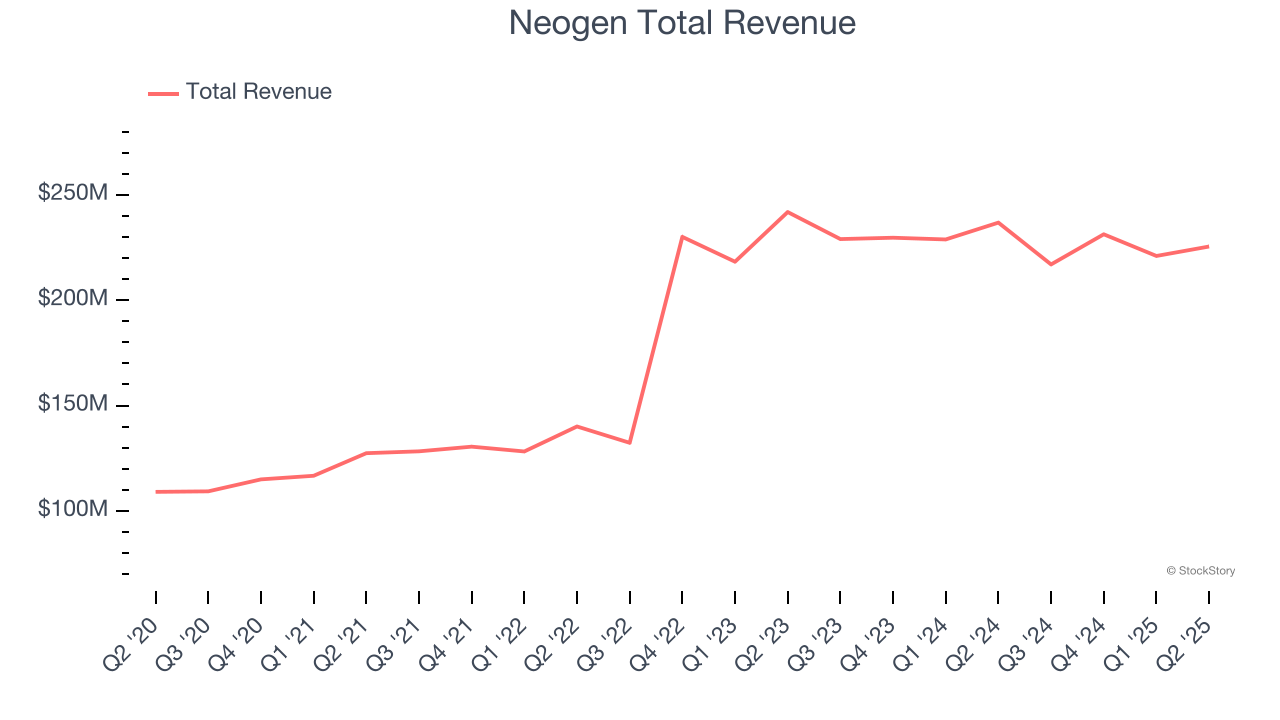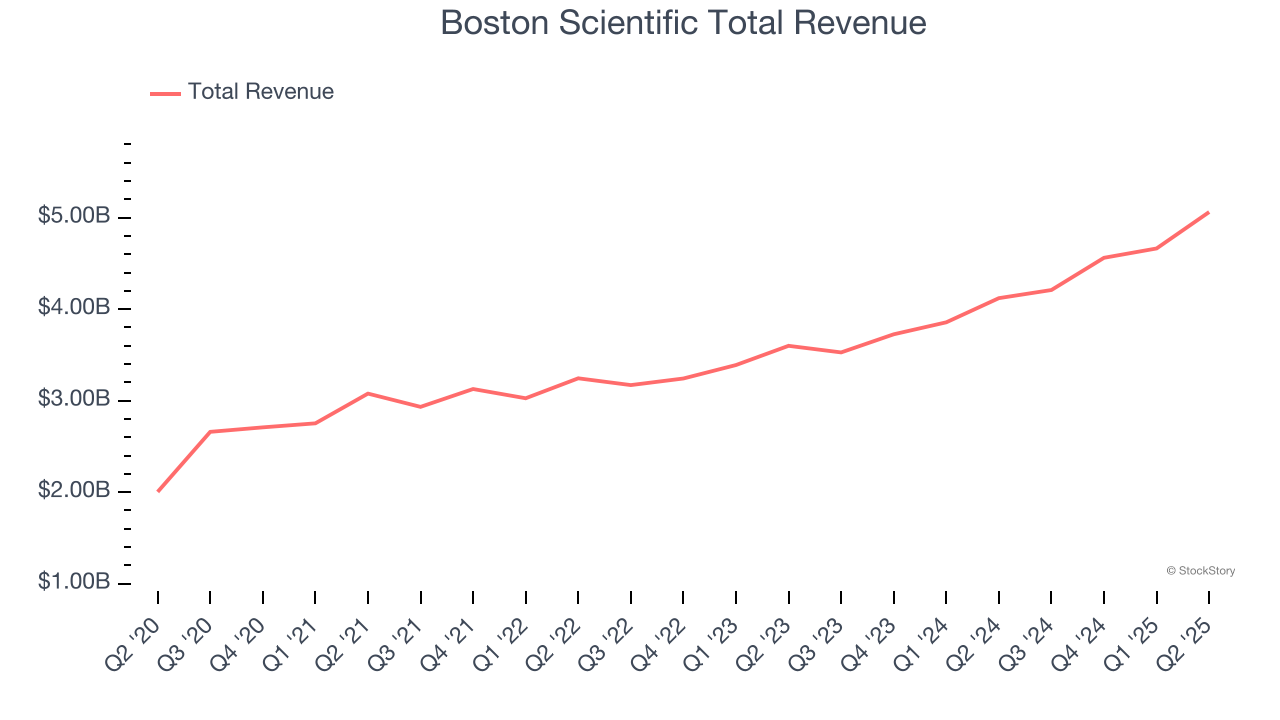
As the Q2 earnings season wraps, let’s dig into this quarter’s best and worst performers in the medical devices & supplies - diversified industry, including Neogen (NASDAQ:NEOG) and its peers.
The medical devices industry operates a business model that balances steady demand with significant investments in innovation and regulatory compliance. The industry benefits from recurring revenue streams tied to consumables, maintenance services, and incremental upgrades to the latest technologies. However, the capital-intensive nature of product development, coupled with lengthy regulatory pathways and the need for clinical validation, can weigh on profitability and timelines. In addition, there are constant pricing pressures from healthcare systems and insurers maximizing cost efficiency. Over the next several years, one tailwind is demographic–aging populations means rising chronic disease rates that drive greater demand for medical interventions and monitoring solutions. Advances in digital health, such as remote patient monitoring and smart devices, are also expected to unlock new demand by shortening upgrade cycles. On the other hand, the industry faces headwinds from pricing and reimbursement pressures as healthcare providers increasingly adopt value-based care models. Additionally, the integration of cybersecurity for connected devices adds further risk and complexity for device manufacturers.
The 5 medical devices & supplies - diversified stocks we track reported a mixed Q2. As a group, revenues beat analysts’ consensus estimates by 1.4% while next quarter’s revenue guidance was in line.
Amidst this news, share prices of the companies have had a rough stretch. On average, they are down 6.3% since the latest earnings results.
Neogen (NASDAQ:NEOG)
Founded in 1981 and operating at the intersection of food safety and animal health, Neogen (NASDAQ:NEOG) develops and manufactures diagnostic tests and related products to detect dangerous substances in food and pharmaceuticals for animal health.
Neogen reported revenues of $225.5 million, down 4.8% year on year. This print exceeded analysts’ expectations by 1.3%. Overall, it was a strong quarter for the company with full-year revenue guidance exceeding analysts’ expectations.
“The softer end-market conditions continued in the fourth quarter, with elevated trade uncertainty and the cumulative effect of the last four years of inflation on food production,” said John Adent, Neogen’s President and Chief Executive Officer.

Neogen delivered the slowest revenue growth of the whole group. Unsurprisingly, the stock is down 9.9% since reporting and currently trades at $4.89.
Is now the time to buy Neogen? Access our full analysis of the earnings results here, it’s free.
Best Q2: Boston Scientific (NYSE:BSX)
Founded in 1979 with a mission to advance less-invasive medicine, Boston Scientific (NYSE:BSX) develops and manufactures medical devices used in minimally invasive procedures across cardiovascular, urological, neurological, and gastrointestinal specialties.
Boston Scientific reported revenues of $5.06 billion, up 22.8% year on year, outperforming analysts’ expectations by 3.4%. The business had a very strong quarter with an impressive beat of analysts’ organic revenue estimates and a decent beat of analysts’ full-year EPS guidance estimates.

Boston Scientific delivered the biggest analyst estimates beat and fastest revenue growth among its peers. The market seems content with the results as the stock is up 3.5% since reporting. It currently trades at $106.80.
Is now the time to buy Boston Scientific? Access our full analysis of the earnings results here, it’s free.
Weakest Q2: Baxter (NYSE:BAX)
With a history dating back to 1931 and products used in over 100 countries, Baxter International (NYSE:BAX) provides essential healthcare products including dialysis therapies, IV solutions, infusion systems, surgical products, and patient monitoring technologies to hospitals and clinics worldwide.
Baxter reported revenues of $2.81 billion, up 4.3% year on year, in line with analysts’ expectations. It was a softer quarter as it posted a significant miss of analysts’ EPS estimates and a miss of analysts’ full-year EPS guidance estimates.
Baxter delivered the weakest performance against analyst estimates in the group. As expected, the stock is down 19.8% since the results and currently trades at $22.50.
Read our full analysis of Baxter’s results here.
Stryker (NYSE:SYK)
With over 150 million patients impacted annually through its innovative healthcare technologies, Stryker (NYSE:SYK) develops and manufactures advanced medical devices and equipment across orthopedics, surgical tools, neurotechnology, and patient care solutions.
Stryker reported revenues of $6.02 billion, up 11.1% year on year. This print surpassed analysts’ expectations by 1.6%. It was a strong quarter as it also logged an impressive beat of analysts’ organic revenue estimates and a narrow beat of analysts’ full-year EPS guidance estimates.
The stock is down 3.3% since reporting and currently trades at $381.27.
Read our full, actionable report on Stryker here, it’s free.
Abbott Laboratories (NYSE:ABT)
With roots dating back to 1888 when founder Dr. Wallace Abbott began producing precise, dosage-form medications, Abbott Laboratories (NYSE:ABT) develops and sells a diverse range of healthcare products including medical devices, diagnostics, nutrition products, and branded generic pharmaceuticals.
Abbott Laboratories reported revenues of $11.14 billion, up 7.4% year on year. This result beat analysts’ expectations by 0.9%. However, it was a slower quarter as it produced organic revenue in line with analysts’ estimates and full-year EPS guidance in line with analysts’ estimates.
The stock is down 2.1% since reporting and currently trades at $129.02.
Read our full, actionable report on Abbott Laboratories here, it’s free.
Market Update
As a result of the Fed’s rate hikes in 2022 and 2023, inflation has come down from frothy levels post-pandemic. The general rise in the price of goods and services is trending towards the Fed’s 2% goal as of late, which is good news. The higher rates that fought inflation also didn't slow economic activity enough to catalyze a recession. So far, soft landing. This, combined with recent rate cuts (half a percent in September 2024 and a quarter percent in November 2024) have led to strong stock market performance in 2024. The icing on the cake for 2024 returns was Donald Trump’s victory in the U.S. Presidential Election in early November, sending major indices to all-time highs in the week following the election. Still, debates around the health of the economy and the impact of potential tariffs and corporate tax cuts remain, leaving much uncertainty around 2025.
Want to invest in winners with rock-solid fundamentals? Check out our Strong Momentum Stocks and add them to your watchlist. These companies are poised for growth regardless of the political or macroeconomic climate.
StockStory is growing and hiring equity analyst and marketing roles. Are you a 0 to 1 builder passionate about the markets and AI? See the open roles here.
